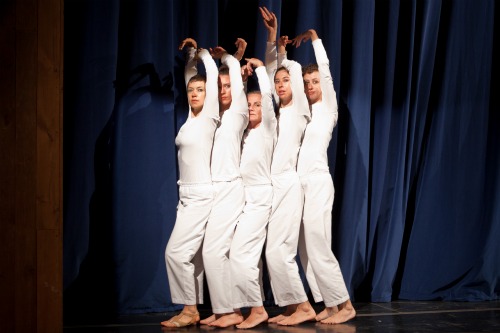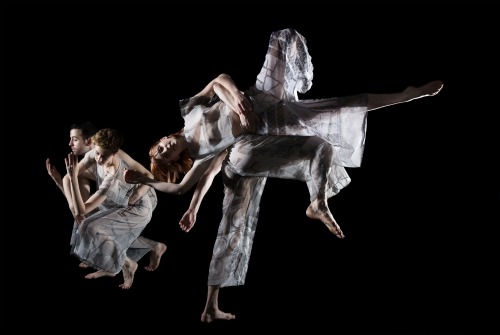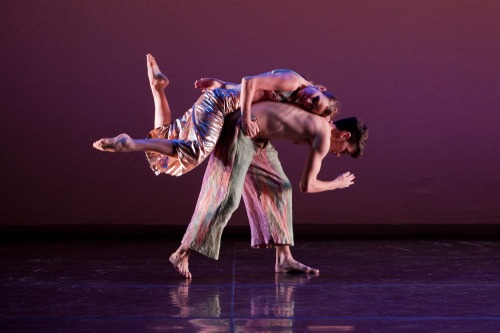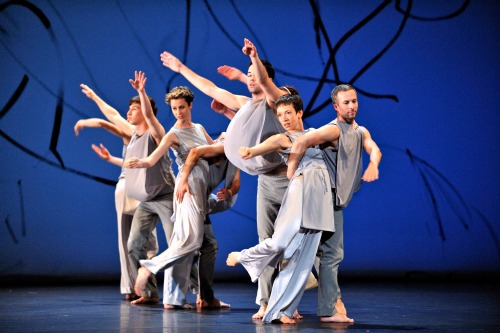Labels like “ordinary” and “everyday” have often been pasted onto Trisha Brown’s movement, especially when someone is alluding to her early work as a member of the iconoclastic Judson Dance Theater. But when has anything she’s ever made been ordinary? Walking may be ordinary, but getting a dancer (to whom she was married at the time) to walk down the side of a very tall building is not your usual stroll (Man Walking Down the Side of a Building, 1970). Many people have rummage sales, but what choreographer stages one underneath a cargo-net ceiling with clothes strung on it, through which dancers have been crawling (Rummage Sale and Floor of the Forest, 1971)? A performer romping around with a film projector strapped to her back so that she acquires a little bouncing-off-the walls double doing the same dance. . .is that an everyday idea or image (Homemade, 1965)?
Making mischief seems to have been imprinted on Brown from the beginning. She messes with our eyes, makes us see space and time differently. Remember her Glacial Decoy (1979)? She built a dance that was too wide for the stage it was performed on, so that one of its four women might have to her movement in the wings? This serious, thoughtful artist has always enjoyed fooling us with her brilliant structural games. That has remained true even as she developed her movement style into a uniquely evasive kind of virtuosity, and even as she allowed traces of narrative to sidle into her works. Think of her titles: If you couldn’t see me (1994) or how long does the subject linger at the edge of the volume (2005). . . .
Brown founded her company in 1970, and its 40th anniversary celebration has continued into its 41st year, with revivals and re-envisionings of older works, plus new ones. The group’s recent performances at Jacob’s Pillow featured a work from each of four decades, and you could see clearly what changed and what remains the same. The movement is simplest in the 1973 Spanish Dance. Five women in plain white pants and long-sleeved matching tops stand profiled in a spaced-out line across the front of the stage. When Bob Dylan’s voice stumbles into “Early Morning Rain,” the woman at the back of the line starts trudging forward in baby steps, hips swinging, arms rising slowly in imitation of a flamenco dancer’s port de bras. When she reaches the woman in front of her, her knees and feet nudge that person into motion. Pretty soon, the audience gets it and starts chuckling. In the end, a five-layered female sandwich bumps into the proscenium arch, halting just as the song ends.
Set and Reset (1983) is not a witty spatial game like Spanish Dance. It, too, challenges your eyes and your ideas of form, but it’s bent on defeating expectations. It’s one of the dances that Brown terms her “unstable molecular structures,” and there’s no predicting the outcome of anything. The semi-transparent wings into which the dancers never fully vanish, the hanging polygonal sculptures by Robert Rauschenberg that capture montaged black-and-white film clips; Rauschenberg’s pale, filmy costumes silk-screened with newsprint; and Laurie Anderson’s questioning voice in her original musical score—all these combine with the choreography to create an image of fluidity and impermanence.
The seven dancers slide in and out of what might become formations and alliances, but these either don’t resolve, or coalesce so elusively and quickly that you can’t grasp them. The movement, even though energetic, has a loose, casual dynamic. The performers often swing one knee to the front, throw a straight arm into the air, or hang a leg put to the side, but these moves aren’t emphasized and immediately twist or melt into something else. People spring into the air as if dropping spongily down again were of equal importance. When they bump into one another, they appear unaware of what caused them to do so and shrug off in a new direction. All is slippery, complex. There’s no point in trying to parse a scene in which seven people all perform different steps in close proximity.
Brown had tamed her rambunctiousness by the time she made Foray Forêt in 1990. Only somewhat, though. The dancers in their golden clothes by Rauschenberg pause occasionally to let your eye alight before they slide away, their limbs and bodies slipping into invisible, intricate channels. When they collide in midair or use another’s thigh as a springboard, you see cause and effect, however speedy. Brown was having physical problems when she made the piece and worrying she might have to retire. The concluding solo she made for herself (now performed by Leah Morrison) suggests a choreographer quietly assessing her own movement vocabulary; her company members stay in the wings, now and then reaching a leg or an arm into view, like fragmented memories.
The piece is a foray into a forest that perhaps evokes one in the Pacific Northwest, where Brown grew up. Things glint into view as you move through a forest, trees obscure then reveal, objects appear and disappear, and you can’t always tell where a sound is coming from. Ideally, Foray Forêt is performed with a live marching band outside the theater. It approaches from far away, is heard faintly, gradually becomes louder, and then diminishes. At Jacob’s Pillow, of necessity, the band was on tape, but strategically placed speakers created a semblance of that illusory village beyond the confines of the stage.
Lighting is a crucial part of Brown’s visions. Rauschenberg lit Set and Reset with Beverly Emmons, and Foray Forêt owes some of its glow to him and Spencer Brown. Jennifer Tipton’s gift for purity serves Les Yeux et l’âme by creating a kind of Eden. In 2011, Brown separated this dance from Jean-Philippe Rameau’s one-act opera Pigmalion (1748), which she directed and choreographed—an event produced by the Festival d’Aix, the Holland Festival, Brown’s company and William Christie’s Les Arts Florissants. As Pygmalion, the opera premiered in Amsterdam in 2010. (I wish I’d seen it there; Brown’s work in opera has always been distinguished by the way she melds the singers and dancers into an intimate ensemble.)
Les Yeux et l’âme floats upon and wreathes around Rameau’s supple, honey-tongued dance tunes. From the beginning of her career, Brown has been in love with forms—at first, ones she created to generate movement. Once she began to use existing music as accompaniment, it was the music’s structure and atmosphere that she allied herself with; rarely does she phrase her movement to its melodies, rhythms, or climaxes.
The dancers in Les Yeux et l’âme (Neal Beasley, Elena Demyanenko, Dai Jian, Tamara Riewe, Nicholas Strafaccia, Laurel Jenkins Tentindo, Samuel Wentz, and Morrison) wear simple clothing by Elizabeth Cannon: pale blue tunics for the women, gray pants and tee shirts for the men. As in all Brown’s works, they’re superbly sensitive to the nuances and gentle complexities of Brown’s movement.
One thing you notice right away is how—coming and going, joining and separating— they wind closely about one another, whether in pairs or groups. Often a dancer curves an arm to reach over and around another’s waist and swing that person off the ground. They form wreathes and arches through which comrades slip. At one point, they assemble into a line stretching away from the audience. There, they create a bewitching, three-part contrapuntal pattern that turns a fence into a sprouting hedgerow. The image is as ornate and as controlled as an 18th-century garden, with a breeze waiting to muss it.
The lobby of the Ted Shawn Theater at Jacob’s Pillow exhibits drawings that Brown made in 2005. She calls them “The Handfall Series.” Their slim black lines loop and skim over the page, sometimes forming a shape your eye can identify. The explanation is that one hand was attempting to draw the path formed by the other hand as it moved over the page. Sometimes a vague outline of fingers emerges. Try to imagine doing this. Only an artist with Brown’s entrancing imagination would conceive of such a venture. It’s like attempting to pin a flower’s windblown shadow to a wall, all the while laughing because you can’t.





How evocative of the early work, all the work, this review is. A colleague of ours once said there is no point in anyone but Deborah writing about Trisha Brown, she does it so well. And I agree with that. But because everything Brown does speaks to me in some way, whether I see it, or read about it, I confess I have made the attempt more than once, so I’m picking up on Deborah’s tentative comment about the influence of her native Pacific Northwest, which I think is profound. Brown grew up on the edge of the continent, the Pacific ocean in front of her, the forest behind her, and I believe this has affected the way she uses space, including a tall building or a water tower the way loggers climb trees. She uses the edges of the proscenium stage in ways no one else does, moreover, except possibly Merce Cunningham, but he too grew up in the Pacific Northwest.
I thank Deborah for pointing out the wit, the humor in Brown’s work; it’s important to remember that it was a component of the Judson Church movement, parts of which are taken way too seriously by academia, as what is not? And I’m grateful as well for the insights into the way Brown uses music, something I hadn’t really thought of.
I’ve always found Deborah’s comments incredibly evocative and so clearly worded that I can see what she’s alluding to with no question, as if I’ve joined her at the dance event. It’s no different here, and it’s a delight to see what she’s seen at the Pillow, all the way back to Judson and to remember with her all that she brings back. I have to say I also love this longer column format, like a delicious meal served with care over many courses, so to speak; I don’t have to worry the server will whisk the plate away before I’m done savoing the last morsel. To carry on the slow food theme– the large selection of photos are the dessert: a delight , enhancing what Deborah’s given us. I too say my THANKS, Judith–
Anyone who read my piece about Trisha Brown prior to this stormy Sunday morning may have been puzzled by a sentence that dwindled away unfinished. For anyone who cared, that has been amended. This is what comes of not having mastered the hyper-active trackpad on my new MacBook Pro (hover above it in the right place and it’ll make you coffee or give you a new best friend). And, of course, double-double checking could have averted the embarrassment.
This marks the first of Deborah’s pieces that I have read. In searching the web for intelligent writing about dance I am glad that I stumbled onto this site. I am quite new to Trisha’s work and have been never more intrigued by the descriptions of her accomplishments as I have been by this article. Thank you Deborah for writing about dance and making us want to see more.